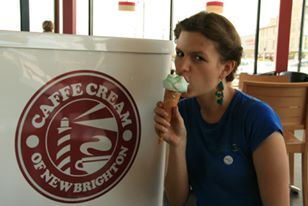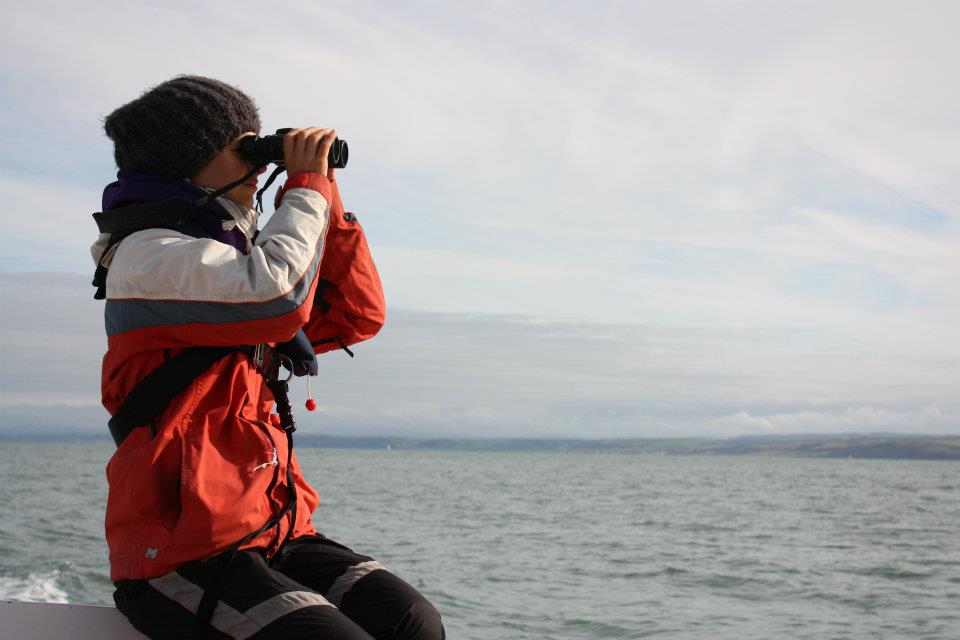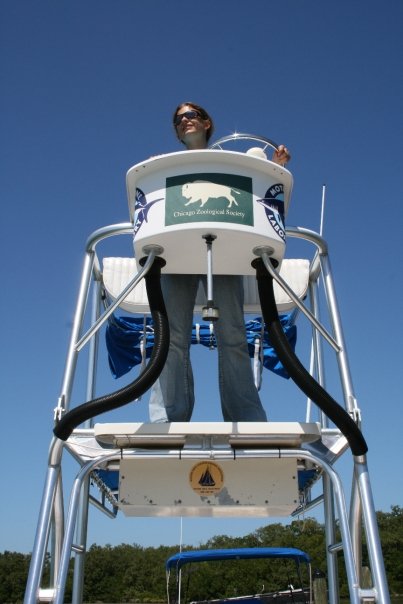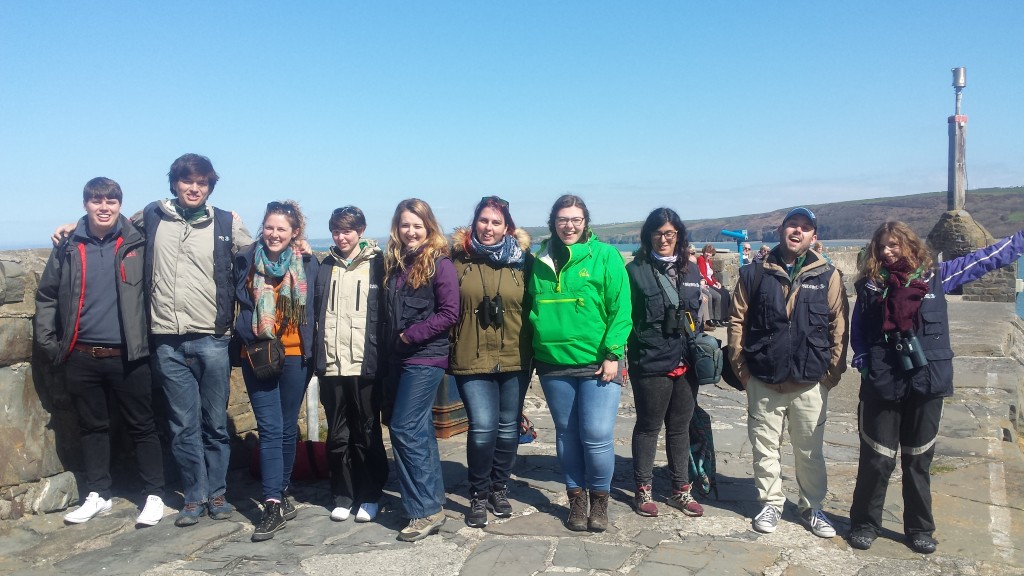An interview with Sea Watch Foundation’s very own Cardigan Bay Monitoring Officer, Katrin Lohrengel.
We thought you might like to get to know us a little better, so one of our volunteers has decided to interview Katrin so we can find out more about her!
 Katrin (2nd right) on the Dunbar Castle II photographing bottlenose dolphins in Cardigan Bay in her role as Monitoring Officer.
Katrin (2nd right) on the Dunbar Castle II photographing bottlenose dolphins in Cardigan Bay in her role as Monitoring Officer.
-
At what age did you decide you were going to pursue a career in conservation and what inspired you?
I decided on animals very early on, for as long as I can remember really, but it took me a bit longer to decide on cetaceans. My parents used to watch a lot of nature documentaries and I was exposed to those from a very early age; I loved all the Jacques Cousteau ones but, perhaps unsurprisingly, I did not have a well formulated plan for my life at that stage! My first real life marine biology encounter happened while my family was living in Oman, I was six, and my parents took me to a marine reserve where we watched and helped (carefully supervised by wardens of course!) turtle hatchlings emerge and waddle towards the water – that was definitely a defining moment! I saw my first wild dolphin when I was 14, Funghi, the Dingle dolphin, and that was probably when I first started thinking seriously about working with marine mammals.
 Not all Sea Watch Regional Coordinator duties involve looking out to sea! Katrin worked with a local ice cream shop to produce ‘dolphin friendly ice-cream’ to raise funds for , and awareness of, the charity.
Not all Sea Watch Regional Coordinator duties involve looking out to sea! Katrin worked with a local ice cream shop to produce ‘dolphin friendly ice-cream’ to raise funds for , and awareness of, the charity.
2. Did you have a job before working for the SWF? If so what?
My first full time job was actually with Sea Watch, although not as Monitoring Officer! As many marine biology students, I spent a lot of time in-between university with unpaid internships, trying to gain as many relevant skills and abilities as possible. Initially I worked part-time for Sea Watch as a Regional Coordinator for nearly 2 years, partially funded by the Vodafone World of a Difference program before I was offered the position of Wales Development Officer, a citizen science project getting members of the general public in Wales involved in cetacean monitoring – which is how we met Angharad! While I was working as Regional Coordinator, I also worked as a dog walker; although not my dream job I do have some fun memories, especially of some of our lovely four legged friends, but I’m afraid dolphins win every time!
3. How did you find out about the SWF in the first instance?
That’s a good question, I think rather mundanely on Environmentjob.co.uk while searching for internships after I graduated from my MSc! I found an advert looking for a Research Assistant and after doing some research on Sea Watch decided this was exactly what I wanted to do. That was in 2011 and I’ve been with Sea Watch ever since! To be honest, I’m not sure how it is possible that it took me so long; I went to Bangor for my undergraduate degree (where we now teach an annual third year course) and was actively looking for marine mammal internships during that time- I ended up going to Florida to intern with the Sarasota Dolphin Research Project at Mote Marine Lab. It was a great experience but I find it quite amusing that I didn’t see what was right in front of my nose at the time!
 Looking for dolphins in Florida as part of the Sarasota Dolphin Research Project.
Looking for dolphins in Florida as part of the Sarasota Dolphin Research Project.
4. What SWF event are you most looking forward to in 2016?
It’s not an event as such but I look forward to the summer season starting so we can get back out on the water, hopefully this year will be less windy than the last and it’s always exciting to meet our new interns at the start of the season!
 Since the interview, the 2016 summer season has started. Here’s Katrin (far right) with our first intake of interns this year.
Since the interview, the 2016 summer season has started. Here’s Katrin (far right) with our first intake of interns this year.
5.How many cetacean species have you seen…and which is your favourite? (if you can choose of course…)
Not as many as I would like, in fact, given that I work with cetaceans I often think it’s a fairly measly compilation compared to some people I know! Overall, including some faraway and brief glimpses, I think I’m at about 16 different species. It’s hard to pick a favourite but just based on how long they eluded me despite occurring regularly in areas I worked; it would probably have to be Risso’s dolphins although as most people, I can’t quite escape the charm of killer whales. I do find it’s not as much about the species as each individual experience; it was magical to wake up to White-sided dolphins bowriding off the Dogger Bank, it was impressive seeing Right whale dolphins whizzing through the water like bullets off Monterey Bay and it was breath taking to see a sperm whale exhale slowly at the surface only metres from our whale watching boat in the Azores.
6. What did you study at University and did you enjoy your course?
I studied Marine Biology/Zoology at Bangor University. I took a year out to gain practical experience and travel before following up with an MSc in Animal Behaviour and Welfare at Queens University, Belfast. I enjoyed both courses tremendously; especially coming out of high school it seemed incredible that suddenly I was in an environment where I had the freedom to choose what I wanted learn and it was all so interesting! Bangor was really good for practical work; I particularly enjoyed the field courses although overall there were limited opportunities to do work on cetaceans, it was mostly seaweed, limpets and barnacles. Now of course, they have the third year field courses with us and we regularly get students doing their dissertations with us, so I feel a little sad that I missed out on all that!
7. If you could ask SWF volunteers to do one thing, what would it be?
First of all I would like to say thank you to all our hard working SWF volunteers, we really could not do our work without you!
I would ask those who are aiming for a career in marine mammal science to take every opportunity they have to learn new skills and gain experience as soon as they can, it’s a competitive field, every little helps and it gets harder to find the time once you are out of university.
And if you’re working in the Sea Watch office, please, please rename your pictures correctly!
8. What is your favourite cetacean-related book? It can be fact or fiction.
I think my favourite cetacean related book is Listening to Whales by Alexandra Morton. She is a scientist who studied the orcas of British Columbia for many years and it is an autobiography of her life with them. It’s a great read, really informative but also highly personal. I first read it just after I graduated from my BSc and thought it was really inspiring.
 Photo: www.raincoastresearch.org
Photo: www.raincoastresearch.org
9.We always see you camera in hand…please send me a photo which you have taken of a cetacean which is your favourite!
Most of my favourite pictures are shot through the water on a calm day when you can actually see the dolphin moving under the surface, it shows the animals in their natural element rather than capturing the fleeting glimpses we get of them at the surface.
Though with my work hat on I should really say, I do also have an appreciation for sharp, crisp, close-up shots of dorsal fins at a right angle, it must be quite frustrating for people who send their beautiful action shots in to get an email back saying, ‘Yes, that’s a great picture, but do you have any fin shots?’- Though probably not as frustrating as when I get the reply; ‘We had loads but deleted them because they were boring.’!
10. What is your advice to all aspiring cetacean photographers out there?
Be prepared! The best pictures are often unexpected so always have your camera with you. And check and adjust your settings regularly, it’s easy to brush against the camera without noticing and then get too caught up in the action to notice you’re essentially taking blank shots because you’re grossly overexposing the pictures- not that that ever happened to me or anything…. Dolphins especially are very fast moving but if it’s very calm you may able to track their movements under the surface, focus on the water and follow them with the camera and you’re poised to get a shot surfacing. And if you get a good fin shot, send it to us! We may be able to tell you who you’ve snapped! I would also say, take a couple of minutes out from behind the camera, it’s easy to get lost in taking pictures and not enjoy the encounter and it can help you get a better idea of what’s going on.
Interview by Angharad Carrington-Edmunds.
























